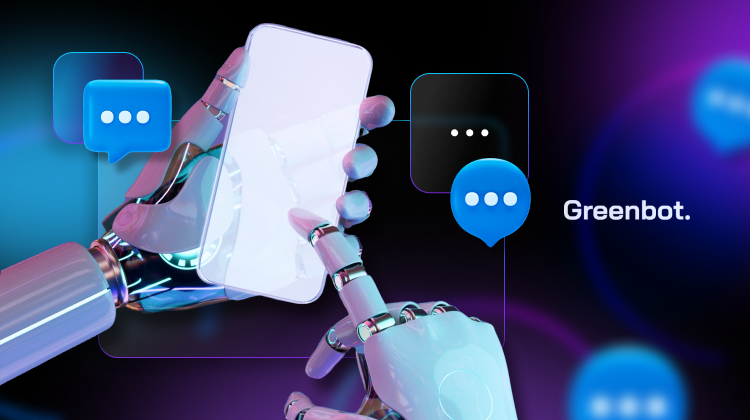
By handling customer queries 24/7, it reduces costs, speeds up responses, and improves customer satisfaction. This article introduces you to how conversational AI can transform your business.
Components of Conversational AI
Conversational AI relies on 6 leading technologies to enable machines to communicate naturally. These include NLP, machine learning, NLU, ASR, reinforcement learning, and response generation.
- NLP: Helps AI understand and process language by breaking it down into simple parts. It involves steps like input processing and output generation.
- Machine Learning: Allows AI to learn from user interactions and improve its accuracy over time.
- Natural Language Understanding (NLU): Deciphers user intent, helping the AI respond accurately.
- Automatic Speech Recognition (ASR): Converts voice inputs into text the AI can understand.
- Natural Language Generation (NLG): Creates responses that fit the conversation.
- Reinforcement Learning: Improves AI responses through continuous learning.
A study by Eunkyung Jo et al. found that conversational AI reduced the workload for health workers by automating routine tasks. It also provided emotional support, showing how AI can address large-scale challenges.
Conversations from these AI models sound very natural, and conversational AI models like ChatGPT have already passed the Turing test, meaning they have given answers that are sufficiently indistinguishable from human responses.
One exciting development of this development is in the advancement of AI girlfriend apps where people flirt with AI applications that mimic emotional conversations so well there is evidence that some people have developed feelings for the chatbots.
How Conversational AI Works
Here’s how conversational AI works in steps:
Step 1: Input Interpretation
When a user interacts with the AI, the system first breaks down the language to understand its structure and intent. This ensures that the conversation feels natural and relevant.
Step 2: Pattern Recognition and Learning
After processing the input, machine learning algorithms recognize patterns from past interactions. The AI adapts to user behavior over time, allowing it to provide more personalized responses. Machine learning helps the system handle different questions and adjust to complex situations.
Step 3: Response Generation
In the final step, the AI constructs a reply that fits the conversation, simulating real human interaction. The goal is to keep users engaged with accurate, appropriate responses.
Most Common Conversational AI
Here are the leading conversational AI tools:
ChatGPT
ChatGPT uses a transformer-based neural network to generate human-like responses in real-time. Trained on large amounts of text data, it can discuss topics ranging from current events to personal advice.
Google’s Dialogflow
Google’s Dialogflow is ideal for businesses, supporting text and voice interactions. It focuses on task-specific interactions like booking services or answering predefined questions. Its structured design makes it perfect for businesses needing predictable conversations.
Microsoft’s Azure Bot Service
Microsoft’s Azure Bot Service helps developers build and deploy conversational AI. It integrates with Microsoft tools like Teams and Office 365, making it ideal for corporate use. Unlike ChatGPT’s open-ended chat, Azure Bot Service and Dialogflow handle specific tasks, providing structured support for enterprises.
NSFW AI Apps
NSFW AI apps are conversational AI apps designed to generate adult-themed conversations. Traditional conversational AI apps have NSFW filters, making it difficult to have adult-themed chats. Even though jailbreaking may be possible occasionally, solutions and patches are usually advanced within hours of discovery.
This has led to an increased demand for dedicated NSFW AI apps. One of the more popular app category types here is sexting AI, which is trained to mimic intimate chats one would get from a girlfriend or partner.
Benefits of Conversational AI

The major advantages include:
Cost Reduction
Conversational AI automates routine tasks, reducing the need for human agents. It speeds up responses, saving time and cutting costs by shortening customer interactions.
Increased Productivity
AI handles multiple inquiries at once, unlike human agents. This frees up staff to focus on complex issues, boosting overall efficiency.
Improved Customer Service
Conversational AI offers 24/7 support, ensuring customers get help anytime. It provides consistent, error-free service, improving satisfaction.
Scalability and Personalization
AI easily scales with business growth, handling more inquiries without extra staff. It uses customer data to deliver personalized, engaging interactions.
Types of Conversational AI Systems
Conversational AI systems come in various forms, each serving specific functions. These systems vary in complexity and meet different user and business needs. The main types include:
Traditional Chatbots
Chatbots handle routine customer questions in real time, reducing service costs. They answer FAQs, recommend products, and track orders.
Generative AI Bots
These bots use deep learning to create text, images, and other content based on user input. They are versatile and useful for content creation, education, and coding help.
Virtual Assistants
Virtual assistants like Siri and Alexa manage tasks, control devices, and provide personalized recommendations through voice commands.
Voice-Activated Systems
These systems, used in smart devices, allow users to control home appliances, entertainment systems, and vehicles through voice commands.
AI Copilots
AI copilots help automate tasks. For example, GitHub Copilot assists developers by suggesting code snippets, speeding up the development process.
AI Agents
AI agents perform tasks autonomously, such as booking appointments or managing support tickets without human supervision.
AI Text-to-Speech Software
This software converts text into spoken words for customer support, audiobooks, and navigation apps.
AI Voice Recognition Software
Voice recognition converts spoken language into text, enabling voice control for smart devices, dictation, and transcription.
Common Challenges in Conversational AI
Conversational AI faces several challenges that impact its effectiveness and fairness.
Handling Ambiguous Language
AI struggles to understand slang, idioms, and nuances in human speech. Despite ongoing improvements in language models, this can lead to misunderstandings and incorrect responses.
Privacy and Security
These systems collect user data, posing risks of breaches. Companies follow regulations like GDPR, but ensuring complete privacy remains difficult.
Mitigating Bias
AI models can reflect bias from training data. Developers work to reduce bias, but completely eliminating it is a continuous challenge.
Conversational AI versus Human Language
Conversational AI tries to mimic human language by recognizing text and speech. It generates natural responses but struggles with context and intent. It often misses the subtleties humans use, like humor and sarcasm.
AI can detect basic emotions through keywords but lacks deeper emotional understanding. It also struggles with cultural context, needing diverse training data to address different traditions and expressions. Fully grasping these nuances is still challenging for AI.
Natural Language Processing (NLP)
NLP helps conversational AI understand human language by breaking down text into smaller parts through tokenization. This allows the AI to interpret each part of a message. Sentiment analysis is also part of NLP, helping the AI detect emotions and generate appropriate responses.
NLP simplifies complex language by turning unstructured sentences into structured data. It breaks down sentences into grammatical components, allowing AI to understand better and respond to messages.
Natural Language Understanding (NLU)
NLU is a part of NLP that focuses on understanding the meaning behind words. It helps AI determine whether a user is asking a question, giving a command, or making a statement. NLU is key to understanding different ways users express their needs.
Contextual understanding is another feature of NLU. It helps AI remember earlier parts of the conversation, allowing for more accurate responses. This ability to retain context makes interactions with AI feel more natural, similar to human conversations.
Conversational AI vs. Rule-Based Chatbots
Conversational AI and rule-based chatbots differ in design and function. Rule-based chatbots follow predefined scripts and respond to specific commands or keywords. They are limited to programmed situations. Conversational AI uses machine learning and NLP to understand context and intent, allowing for more natural and flexible responses.
Rule-based chatbots are simple, making them effective for repetitive tasks like answering FAQs. However, they struggle with unexpected inputs. Conversational AI handles complex interactions and understands language variations. It also learns from past chats, making it more versatile.
Conversational AI, while powerful, requires extensive data and computational resources. It can also make errors with unclear inputs. Rule-based chatbots, though limited, provide consistent responses to specific queries. The choice between them depends on the complexity of the tasks and the type of interaction required.
Use Cases of Conversational AI

Conversational AI is helpful in:
Customer Service
Conversational AI streamlines customer service by using chatbots and voice assistants. It provides instant answers to FAQs, reducing wait times and improving customer satisfaction. AI handles routine queries, allowing human agents to focus on complex issues.
Healthcare
Conversational AI supports patients by answering medical questions, scheduling appointments, and sending medication reminders. It offers 24/7 support, improving access to healthcare information.
E-commerce
Conversational AI acts as a virtual shopping assistant, guiding customers through product searches and purchases. It offers personalized suggestions, making the shopping experience more interactive and increasing sales.
Banking and Finance
In banking, it helps users manage transactions, check balances, and receive personalized financial advice.
Education
In education, conversational AI acts as a tutor. It offers personalized learning, answering questions, and adjusting lessons to fit different learning styles. It also makes education more accessible and engaging for students.
Best Practices for Using Conversational AI
To get the most from conversational AI, businesses should follow these best practices:
Personalization
Tailor responses using user data, such as past interactions and preferences. This makes conversations more relevant and improves user satisfaction. AI should adjust its tone and offer suggestions based on user profiles.
User-Friendly Design
Ensure the dialogue flow is simple and easy to follow. Logical paths and clear follow-up questions make interactions smoother. A user-friendly interface enhances the overall experience.
Privacy and Security
Protect user data with strong privacy measures, like encryption and limited access. Following regulations like GDPR builds trust. Be transparent with users about how their data is collected and used.
Training Data Quality
High-quality, diverse data helps AI understand user questions better. Regularly update training data to improve AI’s accuracy. Poor-quality data can lead to misunderstandings and biased responses.
Differences Between Conversational AI and Conventional AI
Conversational AI interacts with users through natural language, aiming to provide human-like responses. Using NLP and machine learning, it engages in real-time dialogue, answering questions and guiding users.
Conventional AI, however, focuses on analyzing data and making predictions. It works with structured data to detect patterns, forecast outcomes, and provide insights.
Conversational AI handles unpredictable inputs and adapts to user intent. It must interpret ambiguous language and respond accordingly. Conventional AI, in contrast, processes data with precision, focusing on tasks like image recognition or fraud detection without dealing with human nuances.
Conversational AI is used for customer service and virtual assistants, while conventional AI is applied in areas like finance or healthcare, where data analysis and accuracy are crucial.
How to Create Conversational AI
Implementing a conversational AI strategy can change how businesses communicate with customers, help streamline operations, and boost efficiency. Before getting started, it’s important to understand the key steps, which are crucial for successfully integrating this technology into your business.
Define Objectives and Use Cases
Identify the goals you want to achieve with conversational AI. Your goal might be enhancing customer service, improving lead conversion, or reducing costs. Clear objectives will help you choose suitable use cases. These include virtual assistants and customer support bots.
Choose the Right Platform and Technology
Evaluate AI chatbots, like Google Dialogflow, AWS Lex, or IBM Watson. Make sure they align with your integration options and scalability needs. Make sure it supports NLP and NLU.
Consider how well each platform can integrate with your existing systems. It’s important that the platform you choose can scale with your business needs. Flexible integration will help you adapt as your needs change.
Design the Conversational Flow
Map out user interactions with the conversational AI. Develop scripts that guide the conversation logically. Use decision trees to create a seamless experience. Make sure to consider different user inputs, edge cases, and fallback responses. This will help ensure smooth interactions.
Integrate with Existing Systems
Integrate the AI system with your current software, like CRMs, databases, and e-commerce tools. This integration allows AI to access user data and provide personalized responses. Use APIs and middleware to ensure smooth integration and contextual interactions.
Train the Conversational AI
Train the AI with a diverse set of conversational data. This ensures it understands different ways users might phrase their questions. Use NLP to help recognize inputs and NLU to understand user intent. Keep updating the training data to improve AI accuracy.
Test and Optimize
Test the AI thoroughly before launching. Conduct beta testing with real users to identify issues or gaps. Use analytics to track metrics like completion rates and user satisfaction. Use feedback to refine the conversational flow and responses.
Launch and Monitor Performance
Deploy the conversational AI on your chosen channels, such as websites or mobile apps. Monitor key metrics like response time, engagement, and resolution rates. Continuously update and refine based on user feedback to keep the AI effective.
Maintain and Update Regularly
Maintain the AI system to keep it effective. Regularly update it with new queries and responses. Plan periodic reviews and retraining sessions. Stay updated with the latest advancements to ensure the AI remains relevant.
Ethical Considerations in Conversational AI
One major ethical issue in conversational AI is bias. AI systems learn from large datasets, and any bias in this data can be reflected in their responses. This can result in unfair or discriminatory behavior. To prevent this, developers should use diverse training datasets. They should test their models to catch and fix any biases.
Another key concern is data privacy. Conversational AI collects personal info. If not managed, it can pose risks. Developers must use strong data security measures, like encryption, to protect user information. Transparency is essential. Users must know how their data is collected, stored, and used.
Misinformation is a risk when AI provides answers using incomplete or incorrect data. Developers should include fact-checking measures to ensure the AI provides accurate information. Setting ethical guidelines and promoting responsible AI use can help reduce misinformation and maintain user trust.
FAQs on Conversational AI
What Is the Difference Between Chatbot and Conversational AI?
A chatbot follows pre-defined scripts, while conversational AI is more sophisticated. It uses NLP and machine learning to understand context and have dynamic conversations. Conversational AI can adapt to user inputs more flexibly than traditional chatbots.
Which Is the Best Conversational AI?
Popular options include Google Dialogflow, Amazon Lex, and Microsoft Bot Framework. The best choice depends on your needs, like scalability and integration capabilities. Each platform offers unique features suited to different business requirements.
What Is Conventional AI?
Conventional AI involves static systems focused on specific tasks. Unlike conversational AI, it doesn’t learn from chats or act human-like. It mainly relies on programmed rules to solve problems efficiently.
What Is Conversant AI?
Conversant AI is another term for conversational AI. It refers to systems that use natural language to engage users. The goal is to have meaningful interactions. These systems are designed to understand and respond naturally to human inputs.
Conclusion on Conversational AI Technology
Conversational AI improves efficiency, reduces costs, and scales business operations through personalized interactions.
While its benefits are clear, ethical issues like data privacy and bias must be addressed to maintain user trust. As AI evolves, businesses adopting conversational AI will enhance user experiences and stay competitive.






















